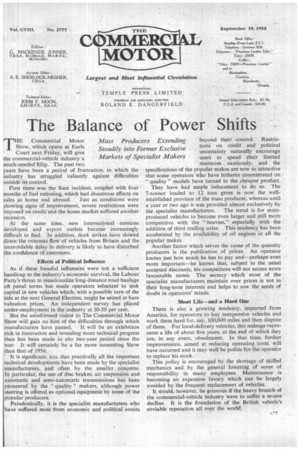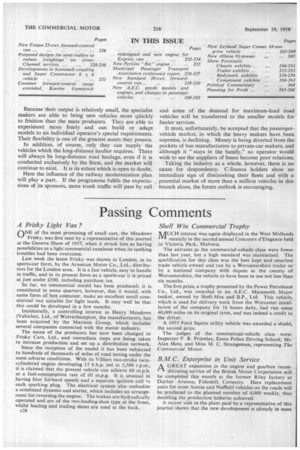The Balance of Power Shifts
Page 73

Page 74

If you've noticed an error in this article please click here to report it so we can fix it.
Mass Producers Extending Steadily into Former Exclusive Markets of Specialist Makers
THE Commercial Motor Show, which opens at Earls Court next Friday, will give the commercial-vehicle industry a much-needed fillip. The past two years have been a period of frustration, in which the industry has struggled valiantly against difficulties outside its control.
First there was the Suez incident, coupled with four months of fuel rationing, which had disastrous effects on sales at home and abroad. Just as conditions were showing signs of improvement, severe restrictions were imposed on credit and the home market suffered another recession.
At the same time, new international• tensions developed and export outlets became increasingly difficult to find. In addition, dock strikes have slowed down the overseas flow of vehicles from Britain and the unavoidable delay in delivery is likely to have disturbed the confidence of customers.
Effects of Political Influence As if these baneful influences were not a sufficient handicap to the industry's economic survival, the Labour Party's threat to renationalize long-distance road haulage oh penal terms has made operators reluctant to sink capital in new vehicles which, with a possible turn of the tide at the next General Election, might be seized at bare valuation prices. An independent survey has placed under-employment in the industry at 30-50 per cent.
But the uninformed visitor to The Commercial Motor Show will gain no hint of the difficulties through which manufacturers have passed. It will be an exhibition rich in innovation and revealing more technical progress than has been made in any two-year period since the war. It will certainly be a far more interesting Show than that of 1956.
It is significant, too, that practically all the important technical developments have been made by the specialist manufacturers, and often by the smaller concerns. In particular, the use of disc brakes, air suspension and automatic and semi-automatic transmissions has been pioneered by the " quality " makers, although power steering is offered as optional equipment by some of the popular producers.
Paradoxically, it is the specialist manufacturers who have suffered most from economic and political events beyond their control. Restrictionson credit and political uncertainty naturally encourage users to spend their limited resources cautiously, and the specifications of the popular makes are now so attractive that some operators who have hitherto concentrated on " quality" models have turned to the cheaper product.
They have had ample inducement to do so. The 7-tonner loaded to 12 tons gross is now the wellestablished province of the mass producer, whereas until a year or two ago it was provided almost exclusively by the specialist manufacturers. The trend is for massproduced vehicles to become even larger and still more competitive with the " heavies," especially with the addition of third trailing axles. This tendency has been accelerated by the availability of oil engines in all the popular makes.
Another factor which serves the cause of the quantity producers is the publication of prices. An operator knows just how much he has to pay and—perhaps even more important—he knows that, subject to the usual accepted discounts, his competitors will not secure more favourable terms. The secrecy which most of the specialist manufacturers maintain over prices is not in their long-term interests and helps to sow the seeds of doubt in operators' minds.
Short Life—and a Hard One There is also a growing tendency, imported from America, for operators to buy inexpensive vehicles and work them hard for, say, 100,000 miles and then dispose of them. For local-delivery vehicles, this mileage represents a life of about five years, at the end of which they are, in any event, obsolescent. In that time, further improvements, aimed at reducing operating costs, will have occurred and it may well-be politic for the operator to replace his stock.
This policy is encouraged by the shortage of skilled mechanics and by the general lowering of sense of responsibility in many employees. Maintenance is becoming an expensive luxury which can be largely avoided by the frequent replacement of vehicles.
It would, however, be grievous if the heavy branch of the commercial-vehicle industry were to suffer a severe decline. It is the foundation of the British vehicle's enviable reputation all over the workl. Because their output is relatively small, the specialist makers are able to bring new vehicles more quickly to fruition than the mass producers. They are able to experiment more freely and can build or adapt models to an individual operator's special requirements. Their flexibility is one of the greatest assets they possess.
In addition, of course, only they can supply the vehicles which the long-distance haulier requires. There will always be long-distance road haulage, even if it is conducted exclusively by the State, and the market will continue to exist. It is its extent which is open to doubt.
Here the influence of the railway modernization plan will play a part. If the programme fulfils the expectations of its sponsors, more trunk traffic will pass by rail and some of the demand for maximum-load road vehicles will be transferred to the smaller models for feeder services.
It must, unfortunately, be accepted that the passengervehicle market, in which the heavy makers have been supreme, is declining. Money is being diverted from the pockets of bus manufacturers to private-car makers, and although it "stays in the family," no operator would wish to see the suppliers of buses become poor relations.
Taking the industry as a whole, however, there is no cause for despondency. C-licence holders show no immediate sign of diminishing their fleets and with a potential market of more than a million vehicles in this branch alone, the future outlook is encouraging.
















































































































































































































